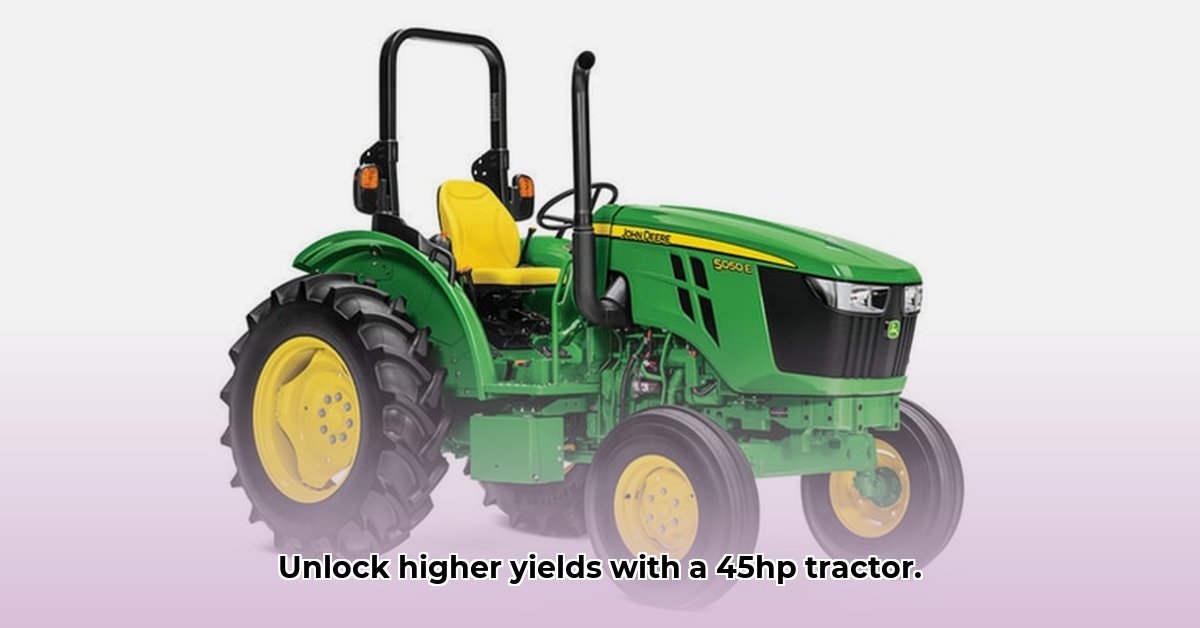
45 hp Tractor: Your Partner in Sustainable Farming
Thinking about boosting your farm's yield? A 45 horsepower (hp) tractor can be a game-changer, whether you're a small-scale farmer or community gardener. Choosing the right one, however, can be daunting. This guide provides actionable steps to find the perfect tractor for your sustainable agricultural practices. For larger operations, consider a more powerful machine, like those discussed on this helpful page.
Decoding Horsepower: Understanding PTO vs. Engine HP
You'll encounter two horsepower figures: engine horsepower and PTO (Power Take-Off) horsepower. Engine horsepower represents the tractor's overall power. However, PTO horsepower is crucial—it indicates the power delivered to implements like tillers and mowers. A 45 hp tractor might have a lower PTO rating (e.g., 38 hp); this is normal. Prioritize PTO horsepower when assessing a tractor's suitability for specific tasks. Planning to pull a heavy plow? The PTO number is paramount. A tractor's horsepower should match your tasks. Overpowering leads to unnecessary fuel consumption and higher costs.
Transmission Types: Hydrostatic vs. Mechanical
Tractors utilize different transmissions: hydrostatic and mechanical. Hydrostatic transmissions offer smooth, continuous control, ideal for precise maneuvers and smaller areas. They're essentially the "automatic" of tractor transmissions. Mechanical transmissions, while often cheaper, provide more gear options and greater control, but require more operator skill. Their durability is excellent for larger plots of land. Consider your terrain and the level of control needed.
Key Considerations Before Purchasing a 45 hp Tractor
Before you start shopping, consider these key factors. Careful planning saves both money and time in the long run.
Land Size and Terrain: How large is your farm? Is the terrain flat or hilly? A compact 45 hp tractor is perfect for small, flat plots, while larger, more rugged terrains might demand a more robust machine.
Tasks: List all tasks the tractor will perform (plowing, tilling, mowing, etc.). Matching tractor capabilities to your needs avoids unnecessary spending.
Budget: 45 hp tractors vary significantly in price. Setting a firm budget prevents overspending. Compare features across price ranges.
Maintenance: Factor in maintenance, potential repairs, and downtime costs. Review maintenance schedules for different models.
Essential Features: Power steering enhances maneuverability, especially in tight spaces. A three-point hitch is standard for attaching implements. Consider a cab for weather protection.
Cabbed vs. Non-Cabbed Tractors: Comfort and Protection
Do you prefer open-air operation or a weather-protected environment? Cabbed tractors offer superior comfort and protection from sun, rain, and dust—but come at a higher cost. Non-cabbed tractors are less expensive but expose the operator to the elements. The best option depends on your climate, usage, and personal preference. Consider your personal comfort and safety.
Step-by-Step Guide to Choosing Your Tractor
Buying a 45 hp tractor is a significant investment. Following these steps ensures a well-informed decision.
Detailed Needs List: Create a comprehensive list of all tasks the tractor will perform. Be precise!
Thorough Research: Compare specifications, read reviews, and pay close attention to PTO horsepower ratings.
Test Drive (if possible): A test drive allows you to assess handling and comfort. Request a demonstration from the dealer.
Multiple Quotes: Obtain multiple quotes from dealers to compare pricing and financing options.
Compliance Check: Ensure compliance with all safety and environmental regulations.
Sustainability: Your Tractor's Role in a Healthier Planet
Fuel efficiency is key to sustainable agriculture. A 45 hp tractor typically offers better fuel efficiency than larger models, reducing environmental impact and operating costs. Optimize sustainability by using the right equipment for each task, minimizing soil compaction, and adhering to a regular maintenance schedule. Maintaining a tractor properly reduces long term costs.
Weighing the Pros and Cons of a 45 hp Tractor
| Pros | Cons |
|---|---|
| Versatile for many tasks | Might be underpowered for large operations |
| Generally more affordable | Less powerful than larger tractors |
| Usually fuel-efficient | Might require more frequent maintenance (depending on the model) |
| Relatively easy to maneuver | Fewer features than larger models |
Choosing the Most Fuel-Efficient 45 hp Tractor
Fuel efficiency is crucial for sustainable farming. Several factors contribute to choosing a fuel-efficient model.
Assessing Your Farming Needs: Understand your workload, matching it to a tractor's capabilities. Over-powering is an unnecessary expense.
Power and Efficiency: Prioritize PTO hp over engine hp. A smaller, efficient engine may outperform a larger, less-efficient one.
Transmission Types: Hydrostatic transmissions offer smooth operation but may be less fuel-efficient than mechanical ones under heavy loads. Consider your typical tasks.
Fuel Types: Explore alternative fuels (biodiesel, electric) if feasible, considering their availability and practicality.
Step-by-Step Guide: 1. Assess farm needs and tasks. 2. Focus on PTO horsepower. 3. Compare fuel consumption rates (if available). 4. Consider transmission type. 5. Investigate alternative fuels. 6. Compare total cost of ownership. 7. Seek expert advice.
Long-Term Considerations: Proper maintenance is vital for extending a tractor's lifespan, reducing waste and minimizing replacements. Choose a tractor with readily available parts and reliable support.
Investing in a 45 hp tractor is a significant decision. With careful planning and research, you can choose the perfect machine to support your sustainable farming practices and contribute to a healthier planet.